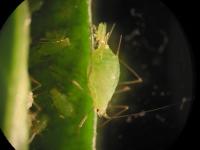
A pea aphid, Acyrthosiphon pisum, gives birth to a baby aphid. The red spots inside the mother are the eyes of baby aphids that still inside her. For pea aphids, the ability to go forth and multiply can depend on a single gene, according to new research.
An overheated aphid with a mutation in that gene can't reproduce.
The gene isn't even in the insect -- it's in tiny symbiotic bacteria housed inside special cells inside the aphid.
"It's the first time a mutation in a symbiont has been shown to have a huge impact on host ecology," said Nancy A. Moran, Regents' Professor of ecology and evolutionary biology at The University of Arizona in Tucson. "One version of the gene is good if the aphids experience heat, and the other version is good if they are in cool conditions."
Neither organism can survive on its own. The Buchnera aphidicola bacteria, which cannot live on their own, supply the aphids, Acyrthosiphon pisum, with essential nutrients.
UA researchers Helen E. Dunbar, a senior research specialist, Alex C. C. Wilson, now at the University of Miami in Coral Gables, Fla., Nicole R. Ferguson, a member of UA's Undergraduate Biology Research Program, and Moran are publishing their findings in the May 2007 issue of PLoS Biology.
Their research paper is titled "Aphid Thermal Tolerance is Governed by a Point Mutation in Bacterial Symbionts." The research was funded by the National Science Foundation and the National Institutes of Health. Howard Hughes Medical Institute provides funding for the UA's Undergraduate Biology Research Program.
Aphids reproduce asexually, so juveniles are clones of their mothers. The symbiotic bacteria are passed on from mother to child. Moran's lab maintains colonies of aphids, each descended from a single ancestral aphid mother.
The scientists found the heat-intolerant gene by accident.
Wilson, then a UA postdoctoral fellow in Moran's lab, was testing the response of some aphid and bacterial genes from one aphid colony. The bacteria's ibpA gene codes for a protein, called a heat-shock protein, that protects the cell's innards from thermal damage.
Wilson expected all the ibpA genes from one colony to be the same.
She was surprised that, after aphids were heated for four hours, some of their symbiotic bacteria produced about 100 times more of the ibpA-encoded heat-shock protein than others.
"It was a huge difference," Moran said.
A piece of DNA called a promoter switches the ibpA gene on or off. The scientists found some of the bacteria had a disabling mutation in their promoters. Those bacteria could no longer manufacture much of the protective heat-shock protein and were therefore killed by the heat treatment.
In another experiment, the researchers gave a 95 F (35 C) heat treatment to aphids whose bacteria carried the mutated promoter, the regular promoter and to Tucson aphids. For each group, the team measured production of a molecule, RNA, that codes for the protective heat-shock protein.
Tucson genes produced three times more RNA than the normal genes from lab colony aphids. The lab colony genes produced about 50 times more than did the genes carrying the mutated promoter.
Aphids proliferate in the summer, and their predator defense can expose them to additional heat.
"When one is bitten, it releases an alarm pheromone and the others all jump off the plant," Moran said. The ground can be more than 20 degrees Fahrenheit warmer than the cool, shady plant.
To test the effect of heat on aphids themselves, the scientists subjected juveniles to 95 F (35 C) for four hours.
The heat-treated aphids hosting bacteria with mutated promoters lived, but didn't reproduce.
"The heat shock kills the bacteria very quickly, although it doesn't kill the aphid," Dunbar said. "But she's sterilized and doesn't have any babies."
The bacteria provide nutrients essential for aphid reproduction.
Conversely, aphids with bacteria with the mutated promoter reproduced faster at the temperatures, 60-68 F (15 - 20 C), at which aphids are maintained in the lab.
Results from wild aphids suggest the genetic makeup of a pea aphid's bacteria depends on climate. Bacteria from Tucson aphids all had heat-tolerant promoters. Bacteria from Michigan or New York state aphids were five to seven times more likely to have the heat-intolerant, mutated promoter.
The two promoters are barely different -- the heat-sensitive version has 10 adenine molecules in a row, and the other has 11.
"The presence or absence of one (adenine) has a huge effect on how well the host does, how well it can survive and reproduce at different temperatures," Moran said.
When a bacterial cell reproduces, a new DNA molecule is copied from the original. But the many adenine molecules in a row makes it easier for a mistake to delete or insert an adenine, causing a mutation, Moran said.
Pea aphids, native to Europe, are now found worldwide. Many other species of insects have similar symbiotic relationships with bacteria. Such easy-to-arise mutations in symbiotic bacteria could explain how some insect pests can expand into new environments, Moran and Dunbar said.
Moran's next step is working with researchers in Wisconsin to see how the bacterial gene variants affect aphids in the field. Source : University of Arizona
 Print Article
Print Article Mail to a Friend
Mail to a Friend
